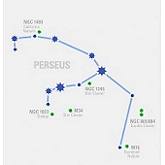
Perseus is the mythological hero who saved Andromeda from Cetus, the Sea Monster. Perseus used Medusa's head (lopped off in a previous adventure) to turn Cetus to stone. At this time of year Perseus is visible in the north-east after dusk. As the night progresses, it rises higher for excellent viewing, and there are a number of fabulous sights on show...
NGC 869/884, the Double Cluster, is a favorite target and with good reason. Use binoculars to get an overview of this jewel box, then a low magnification in your telescope to bring out the distinctly varied coloration of stars in each cluster. Both clusters are about 7000 light-years away and are part of the Perseus arm, one of the spiral arms of our Milky Way.
M76, the Dumbbell Nebula, is another favorite among observers because of its obvious hourglass/dumbbell shape. It's faint and small but responds well to magnification. Averted vision will help you see its two distinct lobes and nebulous wisps.
NGC 1245, an open cluster, is best viewed with low magnification. Most of the stars are hot blue, but there are some nicely contrasting bright orange stars, cooler and older than their blue house mates.
M34, another star cluster, contains about 60 members including several double-stars. The cluster is 1,500 light-years distant and is moving in the same direction through space as the Pleiades.
NGC 1023, an very elongated looking galaxy, hangs in space roughly 30 million light-years from the back of your eye. From that distance it's surprisingly bright, especially the middle. Try all magnifications to pick out structure and details.
NGC 1499, the California Nebula, is a large emission nebula. Under dark skies, it's bright enough to see with the naked eye. Use low magnification and a nebula filter if you have one. See if you can make out the shape of the state that gives the nebula its name.
January 2007


















